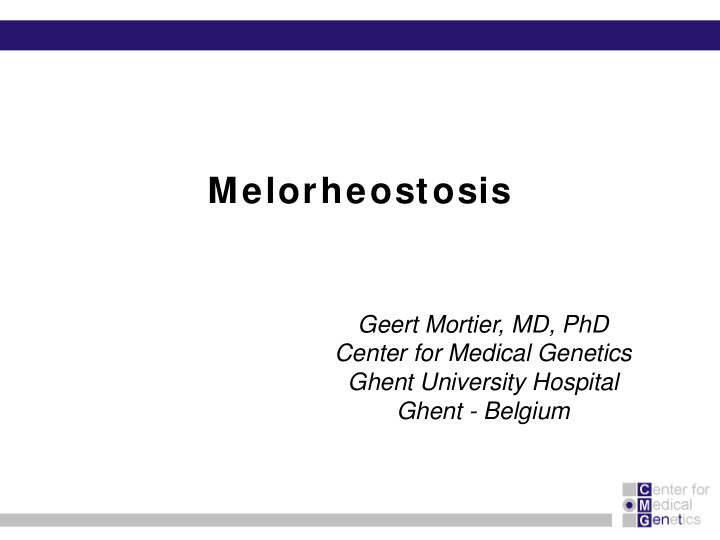



Melorheostosis Geert Mortier, MD, PhD Center for Medical Genetics Ghent University Hospital Ghent - Belgium
Melorheostosis • skeletal dysplasia with increased bone density • prevalence: 1/1.000.000 • Léri A, Joanny J (1922): Hyperostose “en coulée” ou mélorhéostose • usually sporadic occurrence • affecting bone and surrounding connective tissues • asymmetric (sclerotome) distribution • characteristic radiographic lesions
Melorheostosis – radiographic features
Melorheostosis – clinical features • usually symptomatic with chronic pain • scleroderma-like skin lesions • joint contractures, stiffness • shortening and deformation of affected bones • vascular anomalies
Melorheostosis in association with osteopoikilosis
Osteopoikilosis benign condition � � autosomal dominant � hyperostotic spots � isolated or in association with other skin/bone lesions (Buschke-Ollendorff syndrome)
Genome search in three families with osteopoikilosis
Gene mapping � Genome wide linkage analysis � Linkage for two markers on 12q � Region: D12S1048 – D12S1663 � Combined maximum two-point LOD score of 6.691 � Identification of microdeletion between D12S329 and tsc0527430 Region of interest: � 3.07Mb 23 genes � Two candidate genes: WIF1 LEMD3 WIF1 LEMD3 Hellemans J et al. Nat Genet 2004;36:1213
LEMD3: integral protein of the inner nuclear membrane LEMD3 Adapted from Gruenbaum Y et al. Nature Rev Mol Cell Biol 6,21,2005
LEMD3 structure and mutations winged helix RNA recognition motif motif AA 6 49 472 494 627 649 758 777-85 864 MH2 binding transmembrane LEM domain domain motif Hellemans J et al. Nat Genet 2004;36:1213
LEMD3 in BMP/TGF β signaling BMP TGF β
LEMD3 in BMP/TGF β signaling BMP
LEMD3 in BMP/TGF β signaling TGF β
LEMD3 in BMP/TGF β signaling
LEMD3 in BMP/TGF β signaling * p<0.05 * * * *
LEMD3: antagonist in the BMP and TGF β pathway Camurati-Engelmann FOP LEMD3 A. Zwijsen et al. FEBS Letters 546 (2003) 133-139
Analysis of LEMD3 in a larger series of patients • Heterozygous loss-of-function mutations in 17/21 patients with OP/BOS • Heterozygous loss-of-function mutations in 4/4 patients with melorheostosis who belong to a OP/BOS family • Heterozygous loss-of-function mutations (germline) in only 1/30 patients with sporadic melorheostosis Hellemans J et al. Hum Mutat 2006;27:290 and unpublished results
Family D0500261 (c.1963C>T;p.Arg655X)
Family D0601651 (c.2275_2278delGTTA;p.Val759fs)
Family D0601651 (c.2275_2278delGTTA;p.Val759fs) melorheostosis osteopoikilosis
Sporadic case with melorheostosis Patient D0402645
Conclusions • heterozygous inactivating mutations in LEMD3 cause: - osteopoikilosis - the Buschke-Ollendorff syndrome - rare “familial” forms of melorheostosis • the cause of sporadic melorheostosis remains unknown - somatic LEMD3 mutations? - (somatic) defects in the BMP/TGF β pathway? - polygenic? - non-genetic cause?
Fireside chat … Short term goals • need for samples of affected tissues - information on website of patient organisation - database of members - newsletters • study of the natural history • need for expert opinions and advice - centers of reference/excellence?? - meetings with experts present - identify local physicians with interest - educate physicians
Acknowledgments Collaborators Center for Medical Genetics Jan Hellemans George Anadiotis Lina Basel Inge Vereecke Valérie Cormier-Daire Chantal Dewinter Teresa Costa Albert David Kristien Hoornaert Philippe Debeer Bjorn Menten Carrie Fagerstrom Jan Friedman Karen Buysse Sara Hamilton Nadine Van Roy Daniel Kingsbury Jo Vandesompele Klaus Kjaer Barbara McGillivray Frank Speleman Marco Marra Paul Coucke Celia Moss Andreas Janecke Anne De Paepe Johannes Roth Ravi Savarirayan Melorheostosis Association and the patients Wim van Hul Peter Verdonk Fund for Scientific Research (Flanders) Kristien Verschueren Ghent University grant (BOF) Michael Wright European Commission grant (QLG1-CT-2001-02188) Farah Zahir European Skeletal dysplasia Network (www.esdn.org)
More recommend